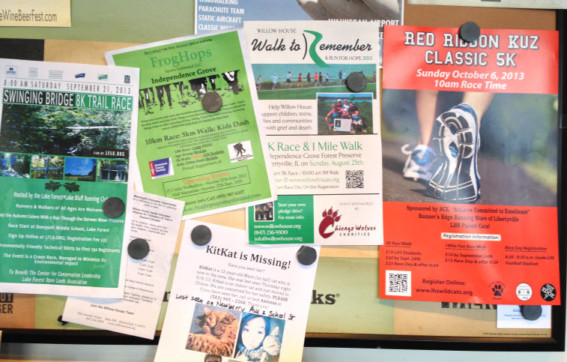Five Ways to Ensure Your Event Makes Headline News

Walk into a coffee shop in any size town, and you will see a bulletin board chock-a-block with posters for charity walks, runs, and similar events. The charity 5K and walk is so common that municipalities struggle to schedule parks and roadways for these events every weekend.
Let’s look at ways to make your event stand out from the crowd and grab some headlines. So how do you make the fact that you’re doing a 5K or walk into news that’s going to get reported? The fact that you’re doing a 5K for a worthwhile cause by itself is not news. Nonetheless, you need media coverage of all types to ensure your event’s success.
The world of journalism and news publishing is changing rapidly. Here are a few ways to ensure your event gets plenty of love from the media:
1. Find the newsworthy stories within your event. Share these. “We’re having a 5K/bike ride/walk this weekend … it’s for a good cause” is not as newsworthy as “couple to marry while running in a 5K for breast cancer research, this is why…”. Well played, the second angle can garner news crews with video cameras to cover your event.
2. Write your posts like a news story. The traditional press release has been eclipsed in the modern news cycle. Instead, we want to make it as easy as possible for journalists to see the news potential of your piece, and give a head start on writing the story you hope they will write. (For more on this, check out a blog post I loved, “The Press Release that Made Me Cry”.)
Include the following key items to make it easier for a reporter or blogger to develop your story into a feature, and increase the likelihood of it getting picked up:
- Direct quotes from “in the know” sources. Original quotes make your story read like news.
- Photos that help tell your story. Great photos can help ensure your story gets picked up.
- Ways for the reader to get more information, including contact details and links to event information and dates.
3. Get to know the alternative and “emerging” news outlets and most influential bloggers (known as “influencers”) in your area. Look for online community news outlets like Patch.com that allow individuals to submit local news stories for posting.
Your story could go further than you think, as reporters for established news outlets may be scanning the community sites for newsworthy stories. Here’s an example from a small local event:
- We posted to the “Trib Local” (a Chicago Tribune local news blog). The piece had started life as an announcement style press release that we rewrote to convert paragraphs about people into quotes by them. Variations went to other informal news outlets.
- A reporter for a regional print newspaper, The Daily Herald, called for an interview shortly after the Trib Local piece was published. The resulting story appeared on the front page of the Lifestyle section the weekend of the event, inspiring a good number of individuals to attend.
4. Get ahead of the news so you can “own” the story, a practice often referred to as “newsjacking”. Kivi Leroux Miller gives an excellent primer in “Newsjacking: The New Way to Get Media Attention“.
One story I love shows how an unexpected event can create unimagined media success for your nonprofit if you get ahead of the story:
- In 2011, runners from the Maryland Half Marathon streamed by the yard where Dozer the goldendoodle sat behind his ‘invisible fence.’ The intrepid dog broke through the ‘fence’ and ran with the runners for 8 miles, stopping to lap water from cups at aid stations, finishing the race at the 2:14 mark. He eventually made his way home – happy, tired and dirty – the morning after the festivities, leaving his owner to puzzle out what had happened.
- That would have been the end of the story, except the University of Maryland Cancer Center that produced the half marathon worked with the owner to tell Dozer’s story and gain priceless publicity for the event. They gave Dozer a ceremonial finisher medal and set up a fundraising webpage for Dozer. The calls and requests for interviews started pouring in. Dozer got his own Facebook page. He became a media darling, with stories and interviews with Dozer and his owner on ESPN, the Today Show, the Baltimore Sun, and countless media outlets and blogs across the world.
- You can’t pay for that kind of publicity. Dozer’s fundraising page raised over $25,000 for cancer research that first year. Dozer had an official role in the Maryland Half Marathon in 2012 and 2013. He was a gift that kept giving, as the nonprofit handled their “star performer” quite well indeed.
5. Create a “surround sound” effect with Facebook and Twitter. Social media channels are essential tools for extending your reach.
- Facebook: If a journalist checks Facebook for additional information, will they find facts, stories and other valuable information about your event?
- Make sure the posts about your event stand out on the organization Facebook page.
- Create a separate Facebook page for your event, if warranted, to allow you to build a community around your event.
- Twitter: Connect and interact with influencers in your community through Twitter.
- Network with influential Twitterati who can share your story and spread the word about your activities.
- Tweet the same angles you’re promoting on your Facebook timeline and news releases; keep the messages coordinated, but make them appropriate to the medium.
- Use relevant hashtags. Have an event hashtag that lets people tweet about the experience preparing and participating, but also broadcast messages to a wider audience by using existing hashtags that relate to the cause your event supports.
The days of monolithic media outlets and sources are gone. All of the methods described above build on each other to help you create the buzz about your event that you need to make it stand out from the crowd.
